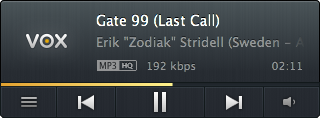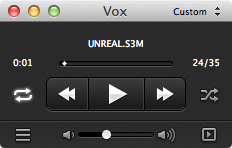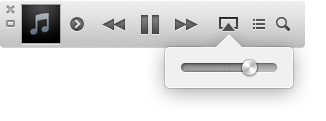
Demoscene tracks have fascinated me ever since I found out about the demoscene sometime around 1995, and to this day they have been the perfect soundscape for my coding endeavors. My playlists include early SID/AdLib tracks, legendary demo scores, music disks and disk mags, and increasingly modern MP3 tracks. Although the number of MP3s is growing, the majority is still a mix of mostly MOD, S3M, XM, and IT tracker files.
When I switched to my first Mac sometime in 2003, I came across CocoModX, which looked pretty slick at the time. I was never really happy with the management of songs, and there was a serious bug that corrupted its database every once in a while.
I don’t remember when I first found out about Vox, but once I realized it could play tracked music, I was in love. The UI of CocoModX had begun to show its age, and Vox’s minimalist UI was a pleasant change:

Underneath the pretty interface, there were a couple of things that made Vox a joy to use with tracked music:
- if you opened a file in a directory, it would load the whole directory as a playlist and then start the playlist at the selected song.
- some tracked tunes have infinite loops, which Vox could detect and skip as soon as the loop point was reached.
- several other settings controlled the exact playback of MOD files which different trackers play slightly differently.
The original Vox app was developed by Alessio Nonni. The latest version in circulation was a beta (0.3b1), but a stable release never emerged, and it seemed like development stopped.
Recently a company named Coppertino released a beta of a new version of Vox. The new app is slick. Very slick. In fact it evokes the same “Wow!”-feeling I had back when I saw the original app for the first time.
Controls subtly fade in and out when you hover over the interface. The orange-to-white progress line looks fantastic. The only thing I am not terribly excited about is the popup volume slider, which places it one click away. I know iTunes’ mini player does it too:


I would still prefer it to be immediately accessible. I understand the aim for a clean look, but you could achieve the same with a volume slider that fades in like in Pandora’s web app, and I would argue the result feels less cluttered than a popup control.

Among all the streamlining, the advanced tracker settings were dropped as well, or rather replaced by some Last.FM integration, which I personally don’t care much about. I am glad it retained the ability to play tracked music, however, and I hope it will stay this way. A couple things that I caught my attention using the new Vox for a couple weeks:
- There is one annoying bug that snuck in: when pausing a song, all currently playing instruments are cut off and are not playing until the next note is triggered. This can take quite some time for ambient tracks.
- I prefer simply using the left/right arrow keys over the Command+arrow key combinations. That’s what iTunes uses too, and those were the key bindings in the old Vox too.
- It would be nice to have finer keyboard control over the volume, currently the stepsize is fairly large, which is a problem when you have in-ear headphones that need fairly low volume settings. Maybe something like the Shift+Option+Volume Up/Down setting in OS X?
Overall it is a beautiful, worthy update to the original Vox app, bringing it back to the forefront of elegant, minimalistic design, while staying true to its roots.
